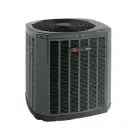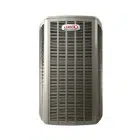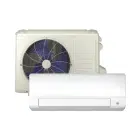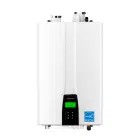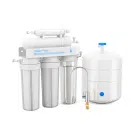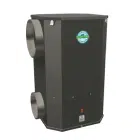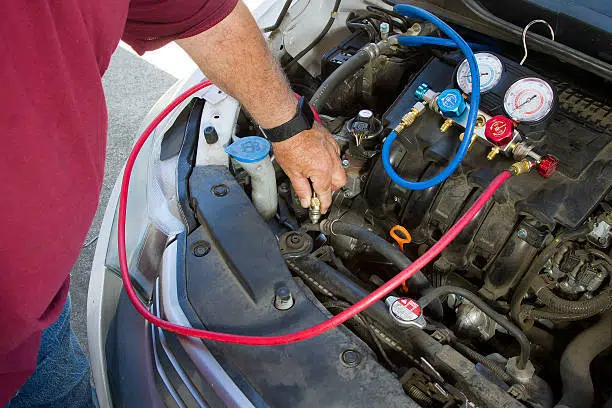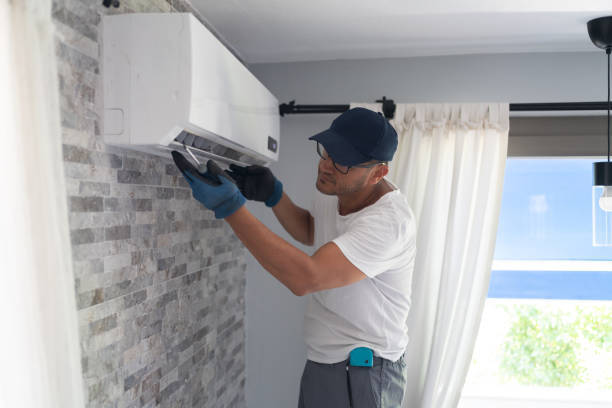
Table of Contents
Freon, or refrigerant, is essential for your AC system to function properly. It absorbs heat from inside your home and releases it outside, keeping your space cool during the Canadian summer. Without the correct amount of freon, your air conditioner can’t cool effectively, which can result in longer run times, higher energy bills, and even damage to critical components like the compressor.
Freon doesn’t get used up, but it can leak due to wear and tear or loose connections. That’s why it’s important to understand how to check freon in AC and recognize when levels might be off. If you suspect an issue, don’t ignore it — early detection can save you from costly repairs.
Common Signs Your AC Might Be Low on Freon
Before you dive into how to check freon in AC, it helps to know what symptoms to look for. Most homeowners notice performance issues long before they realize the refrigerant might be the culprit. If your air conditioner isn’t cooling like it used to, or your energy bills are climbing despite mild weather, low freon could be the issue.
Here are the most common signs your AC might be low on refrigerant:
- Weak Airflow or Warm Air: One of the earliest and most noticeable symptoms is a lack of cold air. If your AC is running but the air coming from the vents feels warm or less forceful, it could mean the refrigerant isn’t doing its job.
- Ice on the Evaporator Coil: Ironically, low freon can actually cause freezing. When the refrigerant level is low, the evaporator coil becomes too cold, causing condensation to freeze. You might notice frost buildup on the indoor unit or the copper lines.
- Longer Cooling Cycles: An AC system low on refrigerant has to work harder and longer to reach the desired temperature. This means it cycles more frequently or stays on for extended periods without effectively cooling the space.
- Hissing or Bubbling Sounds: These are classic indicators of a refrigerant leak. Hissing usually signals a small leak, while bubbling may suggest a more severe escape of freon. These sounds are often heard near the outdoor unit.
- High Utility Bills: Inefficient systems consume more power. If your electric bill spikes without any major changes in usage or weather, the system may be compensating for low refrigerant.
Recognizing these signs early can save you from costly repairs. While this information helps you know what to look for, the next step is understanding how to check freon in AC safely and legally.
Can You Check Freon Levels Yourself?
Technically, no—at least not in the way a certified HVAC technician can. In Canada, checking and handling Freon is regulated by law due to environmental concerns. Only licensed professionals can properly assess, refill, or recover refrigerant. However, if you’re wondering how to check freon in AC on your own, there are still signs you can monitor.
Look for frost on refrigerant lines, listen for hissing sounds, and pay attention to your AC’s performance. If it’s taking longer to cool your space or the air feels warm, these are strong indicators of a possible refrigerant issue.
Still, without professional tools like manifold gauges and temperature sensors, it’s impossible to measure freon levels accurately. So while you can’t fully diagnose the problem yourself, being observant helps you know when to call a technician.
Step-by-Step: How Technicians Check Freon in AC
If you’ve noticed warning signs and you’re ready to bring in the pros, here’s exactly how licensed AC repair service go about checking freon levels in your AC. Understanding this process helps demystify what’s happening during a service call and ensures you’re informed every step of the way.
- System Power-Off and Safety Inspection: Before any gauges are connected, the technician ensures the system is powered down. This step prevents electrical accidents and ensures safe access to the service ports.
- Attaching the Manifold Gauge Set: Using a specialized set of gauges, the technician connects hoses to the low-pressure (suction) and high-pressure sides of the system. These gauges read the current pressures of the refrigerant within the lines.
- Comparing Readings to Manufacturer Specs: Each AC unit is designed to operate within a specific pressure range, depending on the type of refrigerant used (e.g., R-22 or R-410A). The technician checks whether the current pressure matches the recommended values for the outdoor temperature.
- Checking for Superheat or Subcooling: These are advanced methods that help determine if the system has the correct amount of freon. Superheat refers to the temperature increase of the refrigerant vapor after it leaves the evaporator coil. Subcooling measures how much the refrigerant cools below its condensation point. Both methods give a more accurate picture of refrigerant charge.
- Leak Detection: If the pressure readings are low, the technician performs a leak check using electronic detectors or UV dye. Leaks must be repaired before any freon is added to the system—simply topping it off without fixing the issue leads to ongoing problems.
- Recharging the System: Once the leak is fixed and the system is vacuumed to remove air and moisture, the correct amount of freon is added. The technician monitors pressure and temperature readings to ensure the system is balanced and efficient.
This is the only safe and legal way how to check freon in AC. It’s a technical, regulated process that protects not just your AC unit but also your home and the environment.
What to Do If Your Freon Is Low
Discovering that your system is low on refrigerant can feel like a hassle, but it’s critical to act quickly. As you’ve learned, refrigerant issues don’t just impact cooling—they can affect your whole HVAC system. Now that you understand how to check freon in AC properly, it’s time to take the right next steps.
- Don’t just refill—find the leak. Refrigerant doesn’t get “used up.” If it’s low, there’s a leak somewhere. A reputable HVAC technician will always perform a leak test before recharging your system. Ignoring the root cause and simply adding more Freon leads to repeated service calls, higher costs, and possible damage to the system.
- Schedule professional service. Even if you suspect low refrigerant based on symptoms, don’t attempt a DIY recharge. Not only is it illegal without proper certification in Canada, but improper charging can seriously damage your AC system. HVAC technicians use precision tools to ensure your system is charged to exact specifications.
- Invest in preventative maintenance. Regular AC maintenance from a licensed technician can catch small leaks or pressure imbalances before they become big problems. Annual checkups can extend the life of your system and ensure you stay cool all summer long.
Still wondering how to check freon in AC in a safe and effective way? The answer is simple: trust the pros. With the right training, tools, and certifications, HVAC professionals ensure your system is running at peak performance while following all legal and environmental standards.
Need Help? Call Our Licensed HVAC Technicians in Canada
If your AC isn’t cooling the way it used to or you’ve noticed signs of low refrigerant, don’t wait. HVAC Service Solutions offers licensed, experienced technicians across Canada who specialize in diagnosing and repairing refrigerant-related issues.
We offer:
- Full system diagnostics
- Leak detection and repair
- Safe, certified refrigerant recharging
- Maintenance plans to keep your system efficient year-round
Wondering how to check freon in AC the right way? Leave it to our experts. We’re here to make sure your air conditioner runs safely, legally, and efficiently—no matter the season. Call HVAC Service Solutions today and book your service appointment with confidence.
Conclusion
Freon plays a crucial role in keeping your AC system running smoothly, but it’s not something homeowners should handle on their own. Now that you know how to check freon in AC—from recognizing early symptoms to understanding the professional inspection process—you’re better prepared to protect your cooling system and avoid expensive breakdowns.
Whether you’re dealing with a minor refrigerant issue or a full-system malfunction, HVAC Service Solutions is ready to help. Don’t gamble with your comfort or your equipment. Trust the pros, and keep your home cool, safe, and efficient all summer long.
FAQs
1. How do I know if my AC is low on freon?
Common signs include weak airflow, warm air from the vents, unusually long cooling cycles, and ice buildup on the refrigerant lines or evaporator coil. You might also hear hissing or bubbling noises near the outdoor unit, which can indicate a refrigerant leak. If your electricity bill spikes with no clear reason, it may be a result of your AC working harder to cool. These symptoms can point to low refrigerant levels, though only a certified technician can confirm for sure. If you notice any of these signs, it’s a good idea to schedule an inspection right away. Our team at HVAC Service Solutions can diagnose the issue quickly and safely.
2. Can I check freon in my AC myself?
While you can observe signs like ice on the coils or reduced cooling, you can’t accurately check freon levels at home. In Canada, refrigerant systems are regulated and require special tools and certifications to handle. Only licensed HVAC technicians are allowed to legally and safely measure or recharge freon. Trying to do it yourself can lead to system damage and legal penalties. It’s always best to contact a professional if you suspect a refrigerant issue. HVAC Service Solutions offers fast, compliant service you can trust.
3. Is low freon dangerous for my air conditioner?
Yes, running an AC system with low freon can strain the compressor and other key components. Without enough refrigerant, your unit has to work overtime to cool, which leads to increased wear and tear. Over time, this can shorten the lifespan of your system and lead to expensive breakdowns. It also increases energy use, resulting in higher utility bills. Addressing the issue early prevents long-term damage. That’s why understanding how to check freon in AC and calling a pro when needed is so important.
4. How much does it cost to add freon to an AC unit in Canada?
The cost can vary depending on the type of refrigerant (e.g., R-22 or R-410A), how much needs to be added, and whether a leak needs repair. On average, you might pay between $150 and $500, but this doesn’t include the cost of leak detection or repair. Keep in mind that adding freon without fixing the root cause is a temporary solution. At HVAC Service Solutions, we provide transparent pricing and always check for leaks before recommending a recharge.
5. How often should freon be checked in an AC system?
Unlike oil in a car, freon doesn’t get “used up.” If your system is sealed and functioning correctly, you should never need to refill it. That said, checking the refrigerant level is often part of an annual maintenance visit. These checkups help spot leaks early and ensure your AC is operating at peak performance. If you’re wondering how to check freon in AC regularly, your best bet is scheduling a yearly inspection with a certified HVAC technician.
6. Can freon leaks be repaired, or do I need a new AC unit?
Most refrigerant leaks can be repaired, especially if they are detected early. Technicians use electronic leak detectors or UV dyes to locate and seal the leak before recharging the system. However, if your unit is old, has multiple leaks, or uses outdated refrigerant like R-22, replacement might be more cost-effective in the long run. An expert from HVAC Service Solutions can help you weigh your options and recommend the best path forward based on your system’s condition.
7. What happens if I ignore low freon levels in my AC?
Ignoring low freon can lead to inefficient cooling, frequent cycling, and high energy bills. More critically, it can cause your AC’s compressor to overheat and fail, resulting in a repair that could cost over $1,000. Left unchecked, a refrigerant leak can also release harmful chemicals into the environment. Understanding how to check freon in AC and taking action early protects your comfort, your wallet, and the environment.
8. How long does it take to check and recharge freon in an AC?
A licensed technician typically needs 1 to 2 hours to perform a full refrigerant check and recharge. The time depends on system access, whether there’s a leak, and how much refrigerant is required. If a leak is found, additional time is needed for repairs. At HVAC Service Solutions, we aim to complete most standard refrigerant service calls in a single visit while keeping you informed every step of the way.
9. Will low freon cause my AC to stop working completely?
Eventually, yes. If the refrigerant gets too low, the system won’t be able to absorb and remove heat properly. This could cause the compressor to shut down due to overheating or pressure issues. You might still feel air coming from the vents, but it won’t be cold. Over time, the stress on the system can lead to a total breakdown. That’s why recognizing the symptoms and knowing how to check freon in AC can prevent a complete loss of cooling.
10. Who should I call if I think my AC is low on freon in Canada?
If you’re in Canada and suspect your air conditioner has low refrigerant, contact a certified HVAC technician immediately. Handling refrigerant is regulated and must be done by a licensed professional. HVAC Service Solutions is fully certified and experienced in detecting leaks, safely recharging AC systems, and ensuring your cooling unit runs efficiently. We’re here to help you stay cool and compliant—book your inspection with us today.
Share




